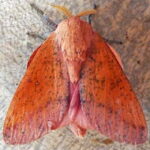Photo Credit: Honeylocust (Gleditsia triacanthos) courtesy Bios Urn®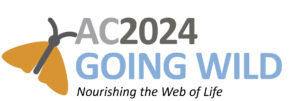
Join us October 26 at the Indiana Native Plant Society’s 31st annual conference as we explore and define our roles in nourishing the web of life.
Back to Annual Conference main page and sponsors.
Speakers
Desiree Narango
Landscaping for Pollinators and Birds at Home
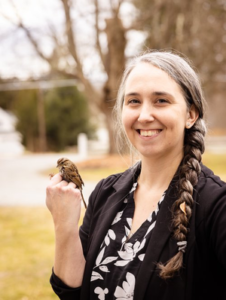 Dr. Desiree Narango will speak about her studies of how residential landscapes and gardening practices influence wildlife habitats. The talk will focus on her recent work comparing how native and nonnative plant species vary in supporting species interactions. She will talk about the relationships between plants and insects, why insects matter to birds, and small steps you can take to improve and restore habitat for wildlife “at home.”
Dr. Desiree Narango will speak about her studies of how residential landscapes and gardening practices influence wildlife habitats. The talk will focus on her recent work comparing how native and nonnative plant species vary in supporting species interactions. She will talk about the relationships between plants and insects, why insects matter to birds, and small steps you can take to improve and restore habitat for wildlife “at home.”
Desiree is a conservation scientist at the Vermont Center for Ecostudies based in White River Junction, Vermont, where she runs a research program focusing on applied ecology and conservation in human-dominated landscapes. She received her M.S. from The Ohio State University and her Ph.D. from the University of Delaware, working with Dr. Doug Tallamy on the effects of nonnative plants on insects and breeding birds in residential landscapes. Prior to her current position, Desiree was a postdoctoral researcher at City University of New York, studying bird and insect communities in urban yards across the United States, and at University of Massachusetts Amherst, evaluating the importance of keystone plants for caterpillars and migratory birds.
Roger Hedge
An Armchair Tour of Indiana’s Ferns
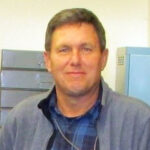 Indiana boasts approximately 80 species of ferns. From our wood ferns, marsh ferns, grape ferns, and spleenworts, to horsetails, ferns come in a variety of shapes and sizes. What these plants lack in displaying colorful, showy flowers, they more than make up for with their varied leaf shapes and patterns. Their distribution and habitats are as varied as their intricate patterns, occurring from northern Indiana’s dunes, wetlands, forests, and prairies to our southern wooded hills, wetlands, and cliffs. One species can even grow as an epiphyte on trees! Roger Hedge will tell us all about these compelling non-flowering plants: basic vocabulary regarding ferns, fern morphology, key field characteristics, and their distribution.
Indiana boasts approximately 80 species of ferns. From our wood ferns, marsh ferns, grape ferns, and spleenworts, to horsetails, ferns come in a variety of shapes and sizes. What these plants lack in displaying colorful, showy flowers, they more than make up for with their varied leaf shapes and patterns. Their distribution and habitats are as varied as their intricate patterns, occurring from northern Indiana’s dunes, wetlands, forests, and prairies to our southern wooded hills, wetlands, and cliffs. One species can even grow as an epiphyte on trees! Roger Hedge will tell us all about these compelling non-flowering plants: basic vocabulary regarding ferns, fern morphology, key field characteristics, and their distribution.
Roger is a retired field ecologist from the Indiana Natural Heritage Data Center’s DNR Division of Nature Preserves. Currently, he is conducting botanical field inventories as a consultant, and enjoys field botany and birding. He is a longtime hike leader at the annual Spring Wildflower Pilgrimage in Great Smoky Mountain National Park, leads bird and plant hikes at the Indiana Dunes Birding Festival, is a board and council member of INPS, and is a member of the Indiana Academy of Science.
Dr. Christian Krupke
Pollinators, Plants, and Ponds: The Unintended Consequences of Modern Corn and Soybean Insect Pest Management
 Corn and soybeans are the largest uses of agricultural land in the United States, and in Indiana. As a result, activities on agricultural lands can and do have implications for non-target land, plants, and animals. Dr. Christian Krupke will summarize research findings from Purdue and elsewhere that quantify the non-target effects of our most commonly used pesticides, including a summary of the current insect pest management landscape and prospects for change in the future.
Corn and soybeans are the largest uses of agricultural land in the United States, and in Indiana. As a result, activities on agricultural lands can and do have implications for non-target land, plants, and animals. Dr. Christian Krupke will summarize research findings from Purdue and elsewhere that quantify the non-target effects of our most commonly used pesticides, including a summary of the current insect pest management landscape and prospects for change in the future.
Christian is a professor in the Department of Entomology at Purdue University. He completed his doctoral degree in entomology at Washington State University in 2004, and since 2005 has worked at Purdue with responsibilities in insect pest management in field crops (i.e., corn, soybeans, wheat and other small grains), where he leads active applied research and extension programs. He also teaches a graduate level course in Integrated Pest Management (IPM). His research has focused upon elucidating the strengths and weaknesses of the primary pest management approaches used in corn and soybeans, with particular focus upon Bt corn and neonicotinoid seed treatments of corn and soybeans. He has published over 50 peer-reviewed manuscripts and given dozens of talks on these subjects to fellow researchers, members of USDA, EPA, USFWS, and multiple stakeholder groups including growers of these commodities, beekeepers, and a wide range of conservation organizations.
Myrene Brown
Spring Ephemerals / No Forest Needed
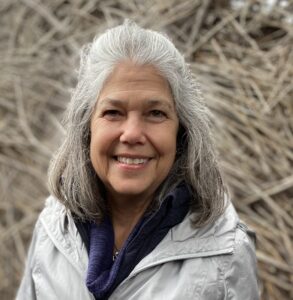 Myrene Brown wants to dispel the myth that growing spring ephemerals takes a forest. Growing spring ephemerals along with other native plants can provide for the insects that start our own food chain. For many of us who love native plants and try our best to provide for insects, early spring can be the time with the lowest number of native plants in bloom, especially if, like Myrene, you live on a full sun site. Myrene’s talk will pass on what she learned after moving to a home with a full sun, blank slate landscape. She is convinced that no forest is needed to enjoy these lovely ephemeral plants near your home while providing good quality wildlife habitat, and she provides tips for propagating and pushing the sun boundaries of spring ephemeral wildflowers. Myrene’s hope is to spark the flow of your own thoughts and garden experimenting towards showcasing spring ephemerals in front yard gardens where these plants can be their own ambassadors by virtue of their beauty and interesting connections to insects.
Myrene Brown wants to dispel the myth that growing spring ephemerals takes a forest. Growing spring ephemerals along with other native plants can provide for the insects that start our own food chain. For many of us who love native plants and try our best to provide for insects, early spring can be the time with the lowest number of native plants in bloom, especially if, like Myrene, you live on a full sun site. Myrene’s talk will pass on what she learned after moving to a home with a full sun, blank slate landscape. She is convinced that no forest is needed to enjoy these lovely ephemeral plants near your home while providing good quality wildlife habitat, and she provides tips for propagating and pushing the sun boundaries of spring ephemeral wildflowers. Myrene’s hope is to spark the flow of your own thoughts and garden experimenting towards showcasing spring ephemerals in front yard gardens where these plants can be their own ambassadors by virtue of their beauty and interesting connections to insects.
Myrene is trained as a clinical microbiologist who shifted to making a living through self-taught garden knowledge when a flexible work schedule was needed while her three children were young. Myrene is a member of the six-person Habitat C.P. R. team that facilitated Zionsville’s recognition as the second Community Wildlife Habitat certified by the National Wildlife Federation. She trained as a Master Gardener through the Purdue-affiliated Boone County Master Gardener program. She credits Doug Akers, the extension agent at the time of her master gardener training, along with Ken Druse and Sara Stein’s books, with increasing her interest in growing native plants. Myrene established Myrene’s Garden in 1998 to provide garden coaching, garden design, and lectures. Myrene’s Garden specializes in native plants, rain gardens, and wildlife habitat gardens while trying to bring the joy of gardening to clients.
Justin Maxwell
What Can Trees Tell Us About the Past Climate in Indiana?
 Understanding how climate and soil moisture have varied in the past provides important information on possible extreme dry or wet periods that in turn inform water management plans. Tree rings have long provided historical context of hydroclimate variability in the U.S. However, tree rings from the Midwest (especially Indiana) were scarce in these previous studies. Justin Maxwell tells us where to find old trees in Indiana and what their growth rings tell us about the past climate. He also shares how our forests may respond to future climate from a growth perspective.
Understanding how climate and soil moisture have varied in the past provides important information on possible extreme dry or wet periods that in turn inform water management plans. Tree rings have long provided historical context of hydroclimate variability in the U.S. However, tree rings from the Midwest (especially Indiana) were scarce in these previous studies. Justin Maxwell tells us where to find old trees in Indiana and what their growth rings tell us about the past climate. He also shares how our forests may respond to future climate from a growth perspective.
Justin is a climate scientist and forest ecologist who studies topics such as changes in drought frequency and the impact of drought on forests. His research focuses on the examination of rainfall variability over time using proxy data from tree-rings and has resulted in over 75 academic articles. He also examines how climate variability impacts tree growth and forest productivity. His past work includes comparing past droughts and wet periods (pluvials) to present-day conditions to help understand what to expect in the future and determine how resilient forests will be to future climate.
Scott Namestnik
Indiana’s Endangered and Threatened Species: What Makes Our Rare Plants Rare
 More than 400 vascular plant species are listed as state endangered or threatened in Indiana. Although some rare plants are considered rare due to several common contributing factors, not all rare plants are necessarily rare for the same reasons. Some of our rare plants are truly rare globally, whereas others are surprisingly common outside of Indiana but are critically imperiled within our political boundaries. Using a number of plant species of conservation concern as examples, Scott Namestnik will look at the factors leading to including plants on our endangered and threatened species list.
More than 400 vascular plant species are listed as state endangered or threatened in Indiana. Although some rare plants are considered rare due to several common contributing factors, not all rare plants are necessarily rare for the same reasons. Some of our rare plants are truly rare globally, whereas others are surprisingly common outside of Indiana but are critically imperiled within our political boundaries. Using a number of plant species of conservation concern as examples, Scott Namestnik will look at the factors leading to including plants on our endangered and threatened species list.
Scott is the Botanist at the Indiana Natural Heritage Data Center, which is part of the Indiana Department of Natural Resources–Division of Nature Preserves. Much of his work involves conducting botanical inventories, assessing sites for protection consideration, and documenting and monitoring occurrences of endangered and threatened species. He has a degree in Botany with a focus in Environmental Science from Miami University and over 25 years of experience with the flora of the Great Lakes region and the Midwestern United States. He is co-author of Wildflowers of the Midwest with Michael Homoya (Timber Press) and Wildflowers of the Indiana Dunes National Park with Nathanael Pilla (Indiana University Press). He is a board member of the Indiana Native Plant Society – North Chapter and heads up the INPS Journal team.

